Choosing a bass player for “Stay Awake” was easy. Andrew Angelin is the most talented bass guitarist I know, and I am honored to play with him under any circumstances. He also joined us in the studio the last time we attempted to record this album, which meant that he was very familiar with our songs, and he had had plenty of time to polish and improve his basslines. I think it shows, in cuts like this slap bass riff from “Flight III”:
Technical skill
Andrew does some very technically interesting things with his bass, and I learn something from him whenever I watch him play. I once saw Andrew slide a harmonic, which I didn’t even think was possible. (He had a hard time replicating it consistently, but maybe I can convince him to pull that trick out on a future album.) I think that Andrew’s bass adds a lot of depth to our songs, and that it makes our songs interesting to listen to over and over because you hear something new every time.
 Sometimes Andrew plays chords on his bass, which is something I think most bass players never consider doing. You’ll be able to hear this during one of his bass solos at the end of “Where is Bobby McGee?” and at the beginning of “Crossing the Bar” for example, and I think it’s a really nice effect during quiet parts of a song. It’s an effect that may be hard to hear over a full band, so it is only useful in some cases, but it is a technique I rarely hear in rock music and I’m glad to be able to bring it to our listeners. I also don’t usually hear harmonics on bass guitars very often, outside of the records of Jaco Pastorius and other virtuoso bass players, but you’ll be able hear those after the bridge on “Break Free” and once again in the outro to “Where is Bobby McGee?”. The trick to using any technically difficult technique on an instrument is to only use it when appropriate of course, otherwise it becomes a gimmick or just showing off, which some people accuse bands like Dream Theater of doing. Like a spice, you just want to add enough to taste, and I think Andrew has done a good job of moderating his technical chops and only bringing them out for punctuation. (Is that a mixed metaphor?)
Sometimes Andrew plays chords on his bass, which is something I think most bass players never consider doing. You’ll be able to hear this during one of his bass solos at the end of “Where is Bobby McGee?” and at the beginning of “Crossing the Bar” for example, and I think it’s a really nice effect during quiet parts of a song. It’s an effect that may be hard to hear over a full band, so it is only useful in some cases, but it is a technique I rarely hear in rock music and I’m glad to be able to bring it to our listeners. I also don’t usually hear harmonics on bass guitars very often, outside of the records of Jaco Pastorius and other virtuoso bass players, but you’ll be able hear those after the bridge on “Break Free” and once again in the outro to “Where is Bobby McGee?”. The trick to using any technically difficult technique on an instrument is to only use it when appropriate of course, otherwise it becomes a gimmick or just showing off, which some people accuse bands like Dream Theater of doing. Like a spice, you just want to add enough to taste, and I think Andrew has done a good job of moderating his technical chops and only bringing them out for punctuation. (Is that a mixed metaphor?)
Choosing the bass
Andrew decided not to use his own electric bass in the studio this time around… last time he recorded with it he heard some rattling that he thought was undesirable. When Andrew tried out Brian’s bass during rehearsal, he liked it a lot and so that’s what we went with.
When Brian bought his bass in the music store, he didn’t have any reason to expect it to sound particularly good, it’s just an inexpensive Specter bass. However, everyone who hears that bass agrees that it sounds particularly good, and when he brought it in for servicing once, the store guy offered to buy the bass off of Brian. This bass just hit a sweet spot for some reason. It’s somewhat comforting to know that in this world of assembly lines and mass manufacturing that some of the mass produced items come out special, despite all attempts at standardization.
We considered using Andrew’s upright bass for “Contained”, but Andrew decided that track’s jazz-rock sound worked better with an electric bass. He also doubted that he could pull off the ridiculously fast bass fill at the end of the bridge with an upright 🙂 We do try to avoid making our musicians’ lives harder than necessary.
Song charts
This may come as no surprise, but one important thing we accomplished during rehearsal for this album was creating/finalizing song charts for everyone to work from. I felt bad about not creating song charts for our musicians ahead of time before rehearsal, but at least with the musicians writing song charts for themselves at rehearsal the song charts were personalized for each of them. I think next time we would try to write out song charts ahead of time, however, so that we could spend more time playing music at rehearsal and less time writing down the basic chords and song structure. It’s quicker to add embellishments/edits to a basic song chart than to write one from scratch.
The aftermath
After each musician recorded their tracks, we interviewed them about their experiences in the studio. For Andrew’s interview, see the video below:
Transcript:
Nelson: Andrew, you just recorded all your bass for this album, how does it feel to be done?
Brian: All your bass are belong to us now!
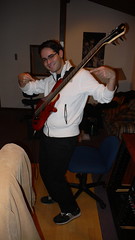 Andrew: Ha ha ha, um, I feel great man, you know, I’m surprised it all got done on time in one day. That never happens. Brian’s bass was definitely the right tool to use, I’m glad he brought it. I had a blast! I’m surprised that we still have like 40 minutes.
Andrew: Ha ha ha, um, I feel great man, you know, I’m surprised it all got done on time in one day. That never happens. Brian’s bass was definitely the right tool to use, I’m glad he brought it. I had a blast! I’m surprised that we still have like 40 minutes.
Nelson: What was your favorite song that you did today?
Andrew: I could say “Last Warning” because there is a very funky bass solo… I dunno, that’s a tough one. I mean, I really enjoyed doing Flight II, because I think that bass line really, you know, it does a lot for me, I don’t know why, it’s a groove thing. Maybe “Break Free”, because that one goes way back, you know, that one goes back to early high school.
Nelson: Nostalgia, right?
Andrew: Exactly, yeah.
Andrew: My least favorite song might have been… well, “The Grinder’s Tale” had a tricky bass line, because it just involves a really strange finger stretch, getting those octaves and whatnot. “Vulture” [now “My Private Asylum”], I don’t know why, I feel like I’ve played it before, and I couldn’t come up with any good ideas for it.
Nelson: Not enough new stuff this time around?
Andrew: Yeah, I couldn’t figure out how to make it more interesting for myself. I feel like I just did the meat and potatoes.
Andrew: You know, we’re ahead of time. Santoro was a great choice for the drums, Portrait was the best choice, I’m glad we’re here and not with Mr. Nuzzo’s place.
Nelson: Ha ha ha
Andrew: The scratch tracks really really helped, so I think you guys should be pretty set. Let’s make this thing a killer album.
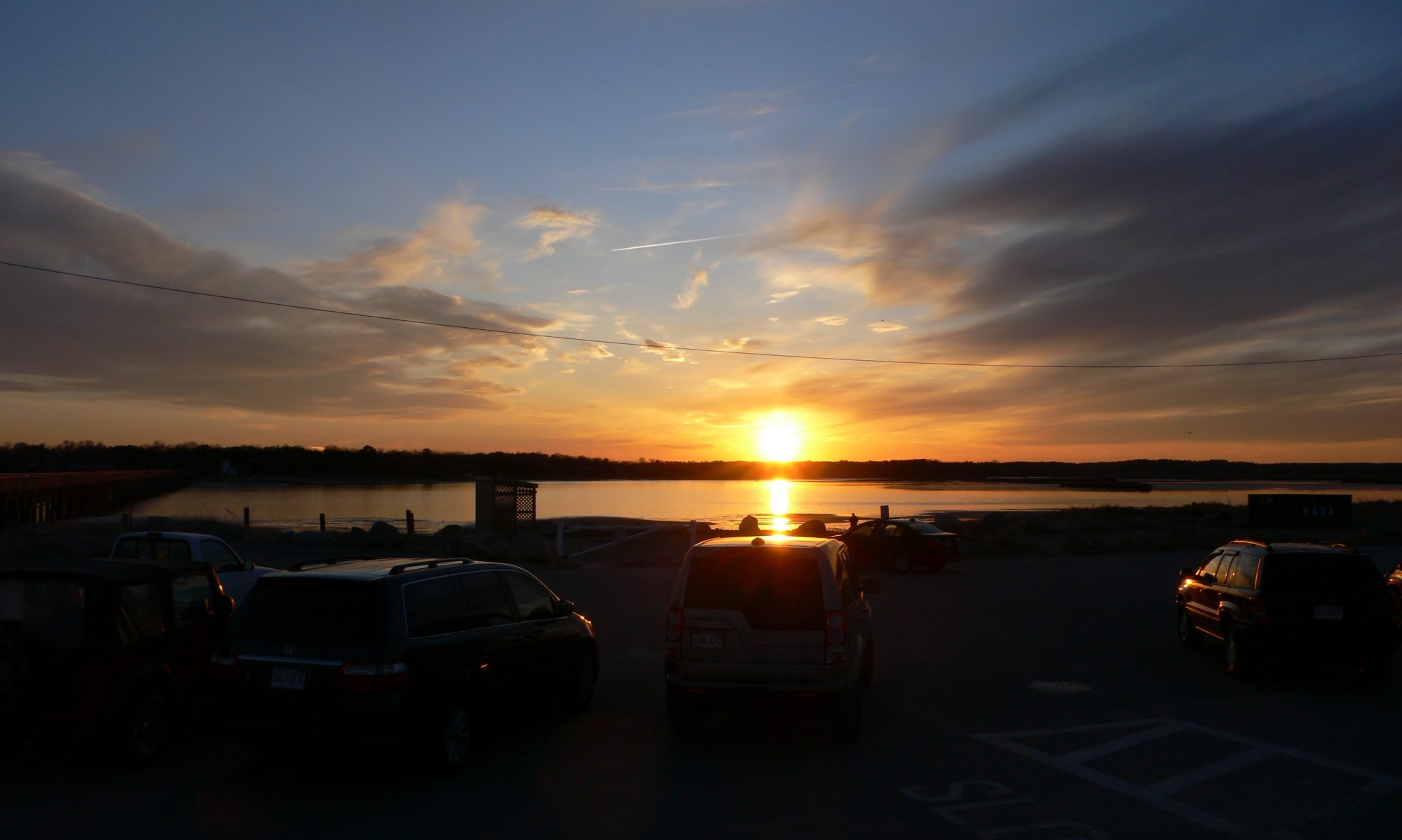
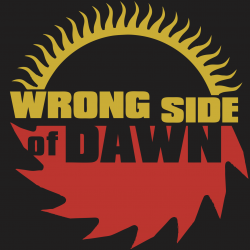
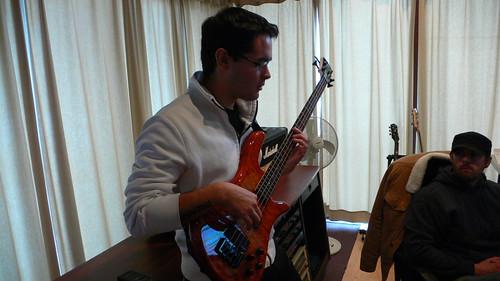
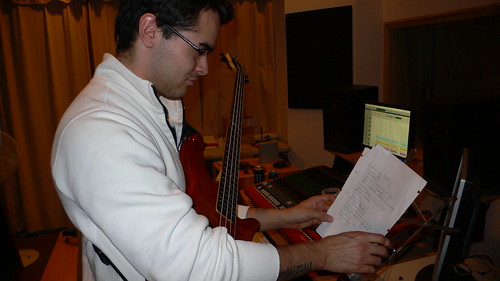
One Reply to “Recording bass with Andrew Angelin”
Comments are closed.